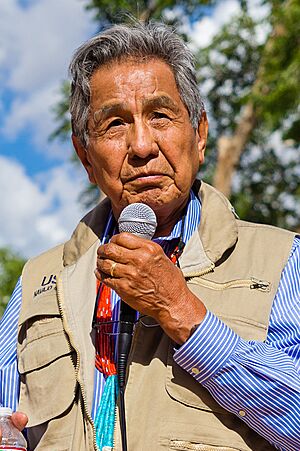1989 Navajo Nation Council reforms facts for kids
The 1989 Navajo Nation Council Reforms, also known as the Title II Amendments, were important changes to how the Navajo Nation government works. These changes aimed to create a clear separation of powers, much like the U.S. Constitution. This means dividing power among different parts of the government:
- The Tribal Council (which makes laws)
- The President (who carries out laws)
- The Supreme Court (which interprets laws)
This system, called checks and balances, helps make sure no single part of the government has too much power. The Council approved these changes on December 15, 1989, and they became law on April 11, 1990.
Contents
Why the Reforms Were Needed
The Navajo Nation has an uncodified constitution, which means its rules are not all written in one single document. Because of this, the Tribal Council can change how the government operates using simple resolutions.
The Story of Peter MacDonald
Before the reforms, the leader of the Navajo Nation was called the Tribal Chairman. This position held a lot of power. Peter MacDonald was the 7th Tribal Chairman. He was known for using his political power widely.
During his time as Chairman, some people raised concerns about how he used his power. There were accusations of misusing funds. These issues led the Tribal Council to try and remove him from office. However, Chairman MacDonald refused to step down.
This led to a difficult situation where, for a time, multiple people claimed to be the rightful Tribal Chairman. Tensions grew, leading to serious disagreements and conflict outside a government building in July 1989. Chairman MacDonald was later removed from office and faced legal challenges. He spent time in prison.
How the Reforms Changed Things
The Tribal Council looked at the challenges with Chairman MacDonald and realized that the government needed better oversight. They decided that too much power was held by the executive leader.
The reforms brought several key changes:
- They clearly defined the separation of powers between the Executive (President) and Legislative (Council) branches.
- They created the new offices of the President and Vice-President of the Navajo Nation.
- They set limits on the powers of both the Executive and Legislative Branches.
- The number of legislative committees was reduced from eighteen to twelve.
- The power to appoint members to these committees was given to the new Speaker of the Council.
What Happened After the Reforms
Later Changes
In 1998, the Tribal Council passed the Navajo Nation Local Governance Act. This law gave local Navajo communities, called chapters, more power to make their own decisions. Later, the size of the Tribal Council itself was reduced significantly, from 88 members to 24.
Different Ideas and Challenges
Some people have pointed out that the Title II Reforms and other changes were made by leaders, not directly by the people through a vote or ballot initiative. Some also believe that a single, written Constitution should be created to prevent future problems.
There's also been discussion about whether the three-branch government model, similar to the U.S. system, truly fits Navajo cultural principles. Some suggest a parliamentary system might work better. Even after the Title II reforms, challenges with corruption continued, and some leaders faced issues, including one President who was removed from office.


